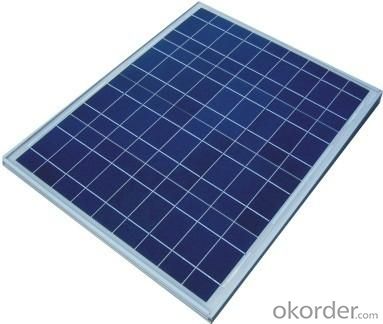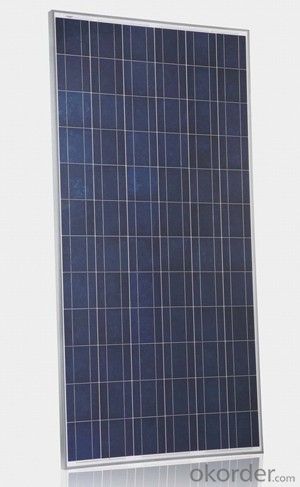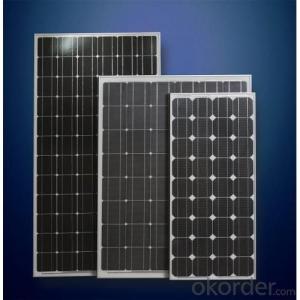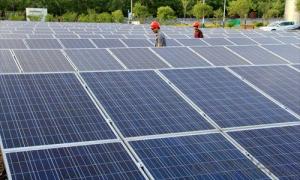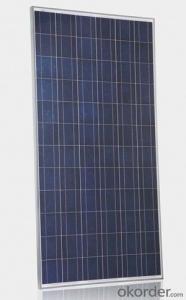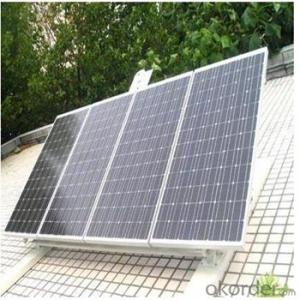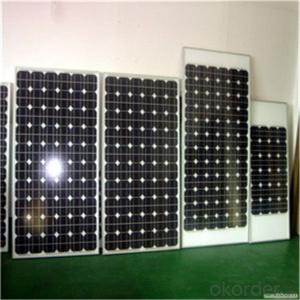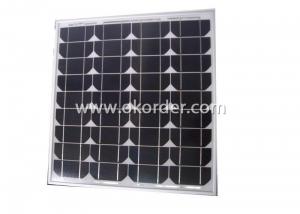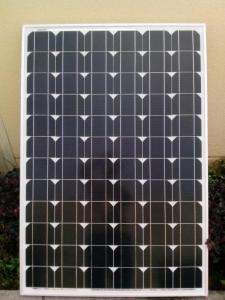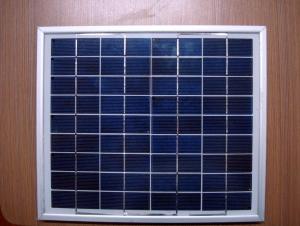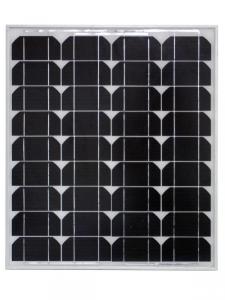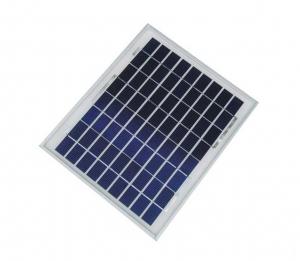Tier One Solar Panels - Monocrystalline Solar Panel Solar Module 55w
- Loading Port:
- China main port
- Payment Terms:
- TT OR LC
- Min Order Qty:
- 100 pc
- Supply Capability:
- 10000 pc/month
OKorder Service Pledge
OKorder Financial Service
You Might Also Like
Quick Details
| Place of Origin: | Zhejiang China (Mainland) | Brand Name: | CNBM | Model Number: | MS-M55(36) |
| Material: | Monocrystalline Silicon | Size: | 760*541*35mm | Number of Cells: | 36pcs |
| Max. Power: | 55w | Appication: | solar power station,home,street light etc. | Cable: | TUV certificate |
| Frame: | aluminium frame | cell size: | 125*125mm mono solar cell | TPT: | Excellent anti-climate TPT with TUV certificate |
| EVA: | Anti-ageing EVA with TUV certificate | Glass: | High transparent low iron tempered glass | cell: | A grade mono cell |
| Junction box: | High quality diode of junction box with TUV certificate | Brand: | Macro-Solar |
Packaging & Delivery
| Packaging Detail: | carton and pallet |
| Delivery Detail: | depend on the quantity |
Specifications
55W mono solar panel solar module
We are manufacturer,can do OEM.
Certified to TUV,CE,ISO9001
Warranty:10 years
55W Solar panel Solar Module
ITEM NO | MS-M55(36) |
Type of cell | Mono |
Maximum power (Wp) | 55W |
Maximum power voltage (V) | 18V |
Maximum power current (A) | 3.05A |
Open circuit voltage (V) | 21.6V |
Short circuit current (A) | 3.29A |
Number of cells (Pcs) | 36 |
Size of module (mm) | 760*541*35mm |
Maximum system voltage (V) | 1000 |
Temperature coefficients of Isc (%) | + 0.1/ °C |
Temperature coefficients of Voc (%) | -0.38/ °C |
Temperature coefficients of Pm (%) | -0.47/ °C |
Tolerance Wattage (e.g. +/-3%) | +/-3% |
Surface Maximum Load Capacity | 60m/s(200kg/sq.m) |
Weight per piece (kg) | 5.0kg |
Junction Box Type | ( TUV ) |
Connectors and Cables Type | (TUV) |
Length of Cables (mm) | 900mm |
Cell Efficiency (%) | ≥15.5% |
Output tolerance (%) | +/-3% |
Frame (Material, Corners, etc.) | Aluminum |
Warranty | 10Years products warranty and 25 years 80% of power |
Standard Test Conditions | AM1.5 100mW/cm2 25°C |
FF (%) | 72% |
Limited Warranty:
10years limited warranty on material and workmanship
25 years limited warrranty of 80% power output
(For detailed please refere to Limited Warranty Certificatd issued by Macro-solar Technology Co.,Ltd)The speicification please find contact us at any time!
- Q: when solar panels have served their purpose, what is done with them?
- Often they get scrapped out or landfilled. Photovoltaics cannot be refurbished. Solar collectors for heating air or water, could be concievably refitted with new clear covering, new insulation, and new heat exchanger, but unless it was a custom installed system you are trying to refurbish, it is more time economical to construct new ones, or to buy new ones.
- Q: I need a solar panel for my laptop as i am going camping in the desert, and i need my laptop. There are two choices of solar panels, One is 0 watts and 2 V and maximum power current 0.56 amps. The other one is 2 watts, 2 V and no mention of current. My laptop plug says input 00-240V and .5A and then output 5V-5A. Which one should i get for my laptop. If there are other choices please tell me ill look them up on OKorder.Thanks
- I'm afraid neither of these panels will do much for charging or running your laptop. If the power brick is supposed to emit 5 volts at 5 amps, that's 75 watts. Neither of those panels provides enough voltage and the power output is obviously far too small. The capabilities of solar power are vastly overestimated for small panels. Sunlight is limited to about kilowatt per square meter under ideal conditions (summer time, clear blue sky, for a few hours around noon in the US southwest). But consumer panels top out at about 5% efficiency, so your limit is 50 watts per square meter - in other words you would need about half a square meter, or about six square feet, of panel to provide 75 watts. And even under ideal conditions you will only get that much for a few hours each day. Also, the panel's voltage output is not regulated, so even if you find a panel that emits 5 volts (this would actually have to be made up of groups of 30 cells in series, as they emit half a volt each at most) you can't just connect the panel output into your laptop's DC in. You'd need a regulated DC-to-DC supply, and since that is not 00% efficient it will cost a bit of the power... now you need even more panel area. All in all, not really a practical thing to carry along on a camping trip.
- Q: Can solar panels be installed on a billboard or signage?
- Yes, solar panels can be installed on billboards or signage.
- Q: Can solar panels be used in cold climates?
- Yes, solar panels can be used in cold climates. While colder temperatures can slightly reduce their efficiency, modern solar panel technology is designed to work effectively in a wide range of temperatures. Additionally, snow can easily be cleared from the panels, allowing them to continue generating electricity during the winter months.
- Q: I've built a set of lights, fan and a clock running on only solar power. The problem is, i have to present it tomorrow and when the light isn't particularly strong it won't work too well. It works flawlessly when its under my desk light on max brightness but the only the light works when i set it to low brightness. Currently, tomorrow in my city it won't be sunny so any advice for trying to make it work under low light?
- Solar panels are designed to be used to recharge a battery or series of batteries, not for direct power. That is the inherent weakness of solar systems. The only way to have it work in low light conditions if to have several cells wired in series and have a voltage regulator to limit the amount of voltage that can be supplied. Other than that, add a battery and a charging circuit that the cell would supply power to.
- Q: Can solar panels be installed on a library or educational institution?
- Yes, solar panels can be installed on a library or educational institution. In fact, many libraries and educational institutions are increasingly adopting solar energy systems to reduce their carbon footprint, lower energy costs, and promote renewable energy education. Installing solar panels on rooftops or open spaces of these buildings can provide clean and sustainable electricity, benefiting both the institution and the environment.
- Q: Can solar panels be used in commercial buildings or industrial settings?
- Yes, solar panels can definitely be used in commercial buildings or industrial settings. In fact, many businesses and industries are increasingly adopting solar energy systems to reduce their reliance on traditional energy sources and lower their carbon footprint. Solar panels can be installed on rooftops, parking lots, or other available spaces, providing clean and renewable energy to power various operations and meet the energy demands of commercial and industrial facilities.
- Q: Can solar panels be installed on a pole or ground mount?
- Yes, solar panels can be installed on both poles and ground mounts. Pole-mounted solar panels are typically used in situations where there is limited space or when the panels need to be elevated for better sunlight exposure. Ground-mounted solar panels are commonly used in larger installations or when there is ample available land. Both options offer flexibility in placement and can effectively harness solar energy.
- Q: I have heard a lot about solar panels and I want to know how these solar panels works and is it really possible to generate electricity using solar panels. And what is the cost of getting a solar panel installed?
- They consist of a semiconductor junction which has an uneven distribution of charge so it has an electric field in it. When light hits the material, an electron is knocked off from its parent atom and can move around the material. The electric field pushes it in one direction, et voila. You have current! (it's most complicated than that, but it needs quantum physics to understand). In summary, light goes in and DC electricity comes out of the panel. To use it in your house you will need an inverter as well, which turns it into useful AC. Then you need a way of using up the extra electricity you produce when it's sunny but you're not using power Some people use batteries, most people use 'grid tied' systems, plug in to the national grid and sell electricity to power companies that you're not using! Unfortunately, without major subsidies (like those offered in Germany, Japan and soon the UK), solar panels aren't likely to be cost effective. In the UK it costs about ?5-6,000 to install a kWp of solar power and it will make about ?90 of electricity a year. In California it's sunnier, so would make about ?200 of electricity a year, but it's still very VERY expensive without subsidy. On the plus side, technology is improving. Thin film technology can be done at half the price, so I'd say hold on until thin film solar cells go up for sale (right now they only sell them to companies for big projects). Prices should drop by at least half in the coming years if they can make enough to sell to households - and at that price it'll be worth it in places like California.
- Q: Does anyone own any and would you recommend them? right now i only own solar stake lights and i use them during the summer in my yard. But during the winter i take them out because they don't charge well. I live in toronto canada where it snows a lot during the winter, would it even be worth it to buy solar panels? Would they get covered with snow if the were mounted on my roof and get ruined? I plan on buying some when i purchase my own home.Any info would be appreciated:)
- You may have to put a snow roof over the wind generator to keep it working. A solar hot water system might be hard investment where you are but it could work if it's designed right. Check out the solar companies in your area for ideas.
Send your message to us
Tier One Solar Panels - Monocrystalline Solar Panel Solar Module 55w
- Loading Port:
- China main port
- Payment Terms:
- TT OR LC
- Min Order Qty:
- 100 pc
- Supply Capability:
- 10000 pc/month
OKorder Service Pledge
OKorder Financial Service
Similar products
Hot products
Hot Searches
Related keywords




